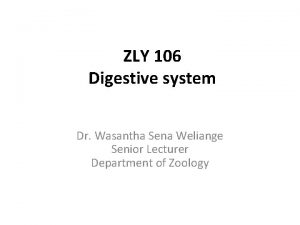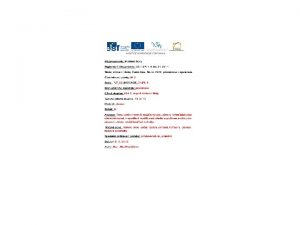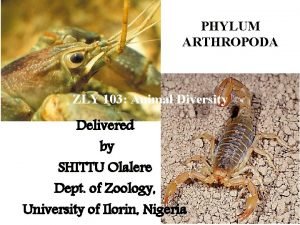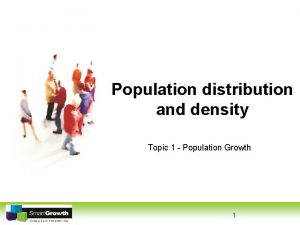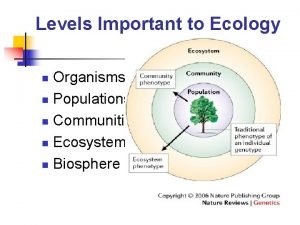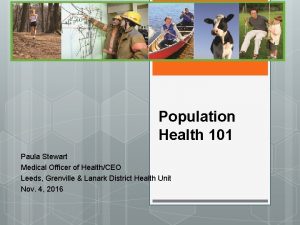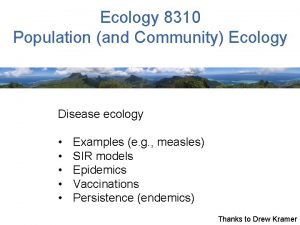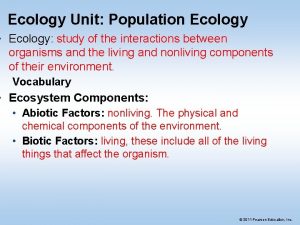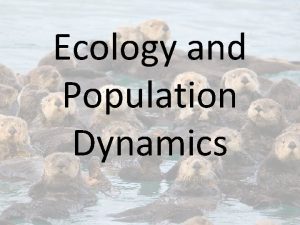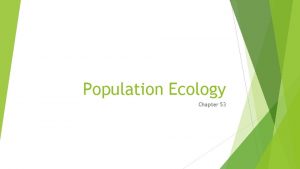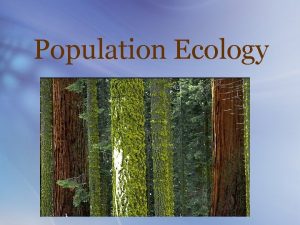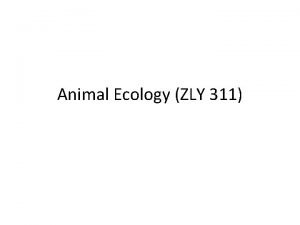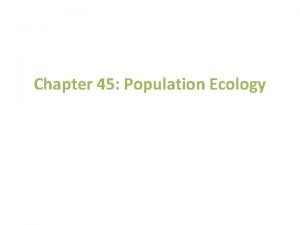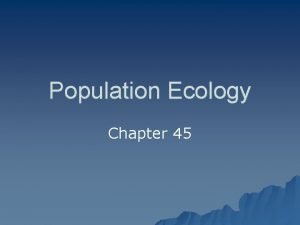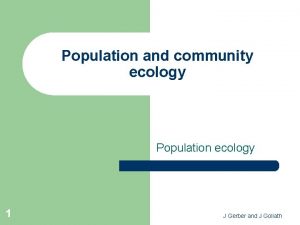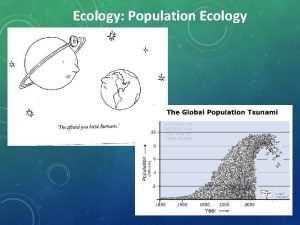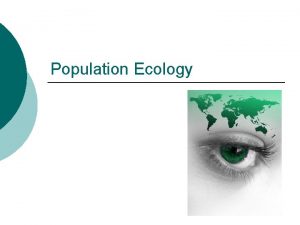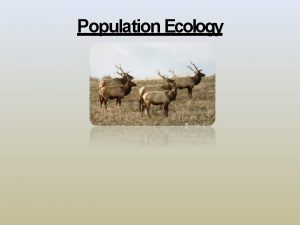Population Ecology ZLY 101 Dr Wasantha Weliange POPULATION





























- Slides: 29

Population Ecology ZLY 101 Dr. Wasantha Weliange

POPULATION ECOLOGY • branch of ecology • We can study 1. structure & dynamics of populations 2. the variables that determine the abundance & distribution of a population a) in time & space b) with regard to environment

Population • is a group of organisms, of the same species, which roughly occupy the same geographical area at the same time.

Different definitions • In human demography – a population is a set of humans in a given area. • In genetics – a population is a group of interbreeding individuals of the same species, which is isolated from other groups. • In population ecology – a population is a group of individuals of the same species inhabiting the same area.

Spatial scale population • Local populations can occupy very small habitat patches like a puddle. • A set of local populations connected by dispersing individuals is called a meta-population.

Scale Level Population • Regional level – population of the region • Island level • – population of an island • Continental level – population of the African continent • Global level – Even the entire species can be viewed as a population

Continent level populations


Differ in their stability • Some populations are stable for thousands of years • Some persist only because of continuous immigration from other areas • Populations on small islands get extinct, but then these islands can be re-colonized.

Characteristics of a population 1. 2. 3. 4. 5. 6. Population size Population density Patterns of dispersion Demographics Population growth Limits on population growth • Above characteristics of a population are shaped by the interactions between individuals and their environments on both ecological and evolutionary time scales, and natural selection can modify these characteristics in a population.

Population size • is the number of individuals living in the defined area • Grassland, lake, pond, river, tundra • increases and decreases over time – resource availability – Competition – Parasitism – Predation – climate – Natality / motality Population density • The number of individuals of a species in an unit area


Natality & mortality • used to calculate the dynamics of a population • key factors determining size of a population over time • Natality – is the greatest influence on a population’s increase • Crude birth rate – number of births per 1000 population/year

Dispersion • Dispersal is movement of individuals or their offspring into or out of an area • regulates population size • mixing of genes between populations is important for evolution • Dispersal is accomplished through – immigration (into a population) – emigration (out of a population) – Migration (frequent movement into or out of a population area).

Dispersion

Patterns of dispersion • Individual members of populations may be distributed over a geographical area in a number of different ways including: 1. Clumped distribution (attraction) - AGGREGATED 2. Uniform distribution (repulsion) - REGULAR 3. Random distribution (minimal interaction/influence) RANDOM

Clumped distribution (attraction)

Uniform distribution (repulsion)

Random distribution (minimal interaction/influen ce)

Age structure = Population pyramid = age pyramid • graphical illustration shows the distribution of various age groups in a population • two back-to-back bar graphs • Population - X axis • Age - Yaxis • Males on the left • Females on the right

POPULATION Growth rate • Population growth occurs when birth rates exceed death rates or immigration exceeds emigration. • Population size regulates by – physical factors • Weather • Water • nutrient availability – biological factors • food availability • Predators • Parasitoids • Competitors • diseases

Factors affecting a population 1. density-dependent – Competition for resources – Food – Parasitism – Predation – Diseases – Toxic wastes 1. density-independent 1. Flood 2. Drought 3. Fire 4. climatic conditions 5. most pest control actions

Population Regulation in an Ecosystem Density Dependant Factors • Shortage of Food – As food will become limited when the population reaches a size, the death rate will increase until the food supply is sustainable for the population to be survive

Population Regulation in an Ecosystem Density Dependant Factors • Predators – increase in population size will result more prey for the species' predators – therefore more chance of that species' members of being killed

Population Regulation in an Ecosystem Density Dependant Factors • Diseases – Diseases spread rapidly across the densely populated area – especially across the same members of a species

Population Regulation in an Ecosystem Density Dependant Factors • Toxic waste – important for organisms living in a small-enclosed ecosystem – a large population produce large amount of waste – increases the risk of disease, and reduces hygiene Salton Sea in imminent danger of drying up, becoming toxic waste dump

Population Regulation in an Ecosystem Density Independent Factors • occur regardless of a population size • environmental disasters 1. forest fire 2. tidal wave 3. Tsunamis 4. Land sides

Population Regulation in an Ecosystem Density Independent Factors • Pollution – Density independent factor that is not determined by a species' population, but by its external environment.

Population Regulation in an Ecosystem Density Independent Factors • Human intervention also has increasingly played a part in determining the population of species – via domestication – consequence from our actions – introductions
 Fat is completely digested
Fat is completely digested Population ecology section 1 population dynamics answer key
Population ecology section 1 population dynamics answer key Population ecology section 1 population dynamics
Population ecology section 1 population dynamics Chapter 4 section 1 population dynamics
Chapter 4 section 1 population dynamics Chapter test a chapter 4 population ecology answer key
Chapter test a chapter 4 population ecology answer key Dobrý sluha ale zlý pán chemie
Dobrý sluha ale zlý pán chemie Spider phylum
Spider phylum Ohen dobry sluha zly pan
Ohen dobry sluha zly pan Oheň dobrý sluha ale zlý pán
Oheň dobrý sluha ale zlý pán Dr wasantha kapuwatta
Dr wasantha kapuwatta Wasantha gunathunga
Wasantha gunathunga Chapter 53 population ecology
Chapter 53 population ecology Population characteristic
Population characteristic Organismal ecology
Organismal ecology Population definition ecology
Population definition ecology Chapter 4 population ecology answer key
Chapter 4 population ecology answer key Chapter 4 section 2 human population answer key
Chapter 4 section 2 human population answer key Concept 3 population ecology
Concept 3 population ecology Ecosystem vs community
Ecosystem vs community Population ecology
Population ecology Ecology def
Ecology def Clumped dispersion
Clumped dispersion Population characteristics
Population characteristics Chapter 53 population ecology
Chapter 53 population ecology Population ecology
Population ecology Chapter 53 population ecology
Chapter 53 population ecology Exponential growth equation ecology
Exponential growth equation ecology What is population ecology
What is population ecology Chapter 36 population ecology
Chapter 36 population ecology Leeds grenville lanark population
Leeds grenville lanark population
